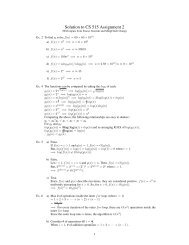Worksheet 40: Graph Representations - Classes
Worksheet 40: Graph Representations - Classes
Worksheet 40: Graph Representations - Classes
Create successful ePaper yourself
Turn your PDF publications into a flip-book with our unique Google optimized e-Paper software.
<strong>Worksheet</strong> <strong>40</strong>: <strong>Graph</strong> <strong>Representations</strong> Name:<br />
<strong>Worksheet</strong> <strong>40</strong>: <strong>Graph</strong> <strong>Representations</strong><br />
In preparation: Reach Chapter 13 to learn more about graphs and graph algorithms.<br />
As you learned in Chapter 13, a graph is composed of vertices, connected by edges.<br />
Vertices can carry information, often just a name. Edges can either be directed, which<br />
indicates an asymmetric relationship, or undirected. In addition, edges can carry a value,<br />
termed a weight. The following is an example graph with directed and weighted edges.<br />
There are two common ways of representing a graph as a data structure. These are as an<br />
adjacency matrix, and as an edge list. To form an adjacency matrix the vertices are<br />
assigned a number. For example, we could number the vertices of the graph above by<br />
listing the cities in alphabetical order: 0-<br />
Pendleton, 1-Pensacola, 2-Peoria, 3-Phoenix,<br />
4-Pierre, 5-Pittsburgh, 6-Princeton, and 7-<br />
Pueblo. An 8 by 8 matrix is then constructed.<br />
Each (i,j) entry describes the association<br />
between vertex i and vertex j. In an unweighted<br />
graph this entry is either 0 if there is no<br />
connection, or 1 if there is a connection<br />
between the two cities. In a weighted matrix<br />
the value is the weight on the arc linking the<br />
two cities, or the value infinity if there is no<br />
connection. In the space at right enter the edge list representation for the graph shown<br />
above. An adjacency matrix requires O(v 2 ) space, where v is the number of vertices. This<br />
is true regardless of the number of edges.<br />
The alternative representation, the edge list, stores only the edges of a graph. This is<br />
advantageous if the graph is relatively sparse. Fundamentally, the edge list uses a map<br />
indexed by the vertex (or vertex label). For an unweighted graph the value is a set of<br />
vertices that represent the neighbors of the key vertex. In a weighted graph the value is<br />
itself represented by another map. In this map the key is the neighboring vertex, and the<br />
0<br />
1<br />
2<br />
3<br />
4<br />
5<br />
6<br />
7<br />
0 1 2 3 4 5 6 7<br />
An Active Learning Approach to Data Structures using C 1
<strong>Worksheet</strong> <strong>40</strong>: <strong>Graph</strong> <strong>Representations</strong> Name:<br />
value is the weight of the arc that connects the two vertices. Complete the following<br />
edge list representation of the earlier graph. One entry has been made for you already.<br />
Pendleton: {Pueblo: 8, Phoenix: 4}<br />
Pensacola:<br />
Peoria:<br />
Phoenix:<br />
Pierre:<br />
Pittsburgh:<br />
Princeton:<br />
Pueblo:<br />
Let v represent the number of vertices in a graph, and e the number of edges. Assuming<br />
that e > v, the edge list representation requires O(e) storage.<br />
An Active Learning Approach to Data Structures using C 2

















